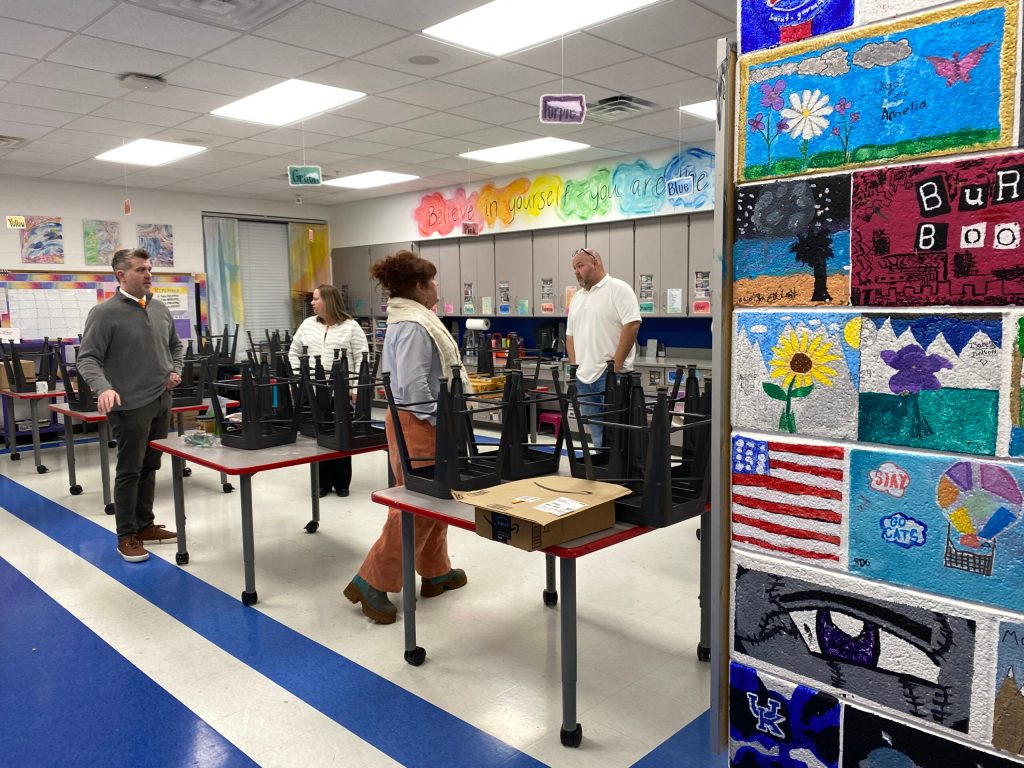School Board meets, discusses mental and behavioral health, and Rosenwald Dunbar Elementary School
Published 11:24 am Monday, January 20, 2025

- Photo: (Left to Right): Rosenwald Dunbar Elementary Principal, Joe Payne, shows Superintendent Sara Crum, and Board Members Debbie Hood and Bobby Welch the school’s art room with plenty of unique student creations. (Photo by Gillian Stawiszynski).
|
Getting your Trinity Audio player ready...
|
The Jessamine County Board of Education met for the first time this year for a work session and a quick special called meeting to vote for the Board’s chair and vice chair for the next two years.
The Board re-elected Steven Scrivner as chair, and elected Bobby Welch as vice chair.
At this month’s work session, board members and Superintendent Sara Crum discussed several topics, including the District’s mental and behavioral health help structure for students. The meeting started with Principal Joe Payne updating the Board about Rosenwald Dunbar Elementary.
Payne said the school’s family engagement activities are “extremely well-attended,” including the math and literacy night at the school, with over 500 people attending. He praised the Crosswoods Church, which he said is a “fantastic” support to the school and staff, in part by helping the school with food bags that go home with kids. “Which is, of course, a reason why we’re so excited to get students back in the building, so we can get eyes on the students we have concerns about,” Payne said, referring to the snow and ice remaining from the recent storm that has kept kids out of school due to snow and ice-piled roads since Monday, Jan. 6.
Payne said one thing the school has really been focused on this year is supporting its special education students. For the first time on iReady testing, students with disabilities outperformed students without disabilities in growth. “That’s a huge celebration, but that’s a lot of work to do (for teachers and students),” Payne said.
Superintendent Sara Crum asked Payne what the school needed, and he responded, “Staffing is super important, and of course raises go into that. And you all do a great job.”
After Payne spoke to the Board, they took a quick tour of the school. They started with the library, which got a “huge facelift,” according to Payne, and then went into the art classroom, which had dozens of unique student artworks. The Board also saw a classroom with two whiteboards for different lessons to be done at once and new, easily movable classroom furniture. The Board also saw the gym, which had just had its bleachers replaced.
The work session continued with the rest of the Board’s Discussion items, starting with a Director of Student Services update from Beth Carpenter.
Carpenter’s presentation was about school structures for student services regarding mental and behavioral health. It highlighted the three tiers of intervention structure available for students and what the implementation of the intervention levels looks like. This presentation does not include in-class instruction and guidance.
This presentation also includes data showing that students seek out counseling services for themselves. The three-month average of students going to receive these services through self-referral is 3,000 kids. Referrals to receive services also come from guardians and teachers, but not nearly as many as the kids who make their own decisions.
Tier one is “universal intervention-prevention and proactive,” and it is the first level of intervention, including social and emotional regulation learning, a counselor-referral process, lessons on cyber safety and bullying, and “student connections” programs in each school. Tier two is “targeted intervention,” which some students may move up to depending on their behaviors. This level includes mentors, small social groups, and a 504 (disability support plan). Tier 3 intervention is the highest level of intervention, named “intensive intervention,” where some students may have case workers assigned from the community, counseling outside of the school, and intensive check-in time at school.
Carpenter said all schools in the District now collect data based on student referrals, whether from disruption or fighting. This helps the school support systems determine what students are having problems with and what their specific needs are. This is important so that students get the right individualized help.
Although each school has counselors, and the mental and behavioral programs are growing, the referral process alone can take 1-3 hours per student. Carpenter explained that the school’s intervention structure must utilize outside agency support and community support, including a partnership with the Kentucky Center for Grieving Children. Beth and the District’s Student Support Services team works hard on grants to get their program the money it needs to function.
In other news:
- The Board approved the District’s Chief Financial Officer’s request to install 1,000 bleacher seats at East Jessamine Middle School to accommodate the expected number of students.




